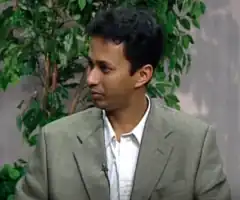
Subhankar Banerjee (born 1967) is a photographic artist, educator and activist whose images of the Arctic National Wildlife Refuge and other Alaskan wild lands have captured international attention.
Early life
Born in Berhampore, India, Banerjee received his bachelor's degree in engineering before moving to the United States, where he received master's degrees in physics and computer science. He worked in scientific fields for six years at the Los Alamos National Laboratory in New Mexico and Boeing in Seattle. In 2000, his childhood passion for art, coupled with a deep love and concern for the wilderness and disappearing indigenous cultures, caused him to leave his career in science to pursue art. Since then he has focused all his efforts on indigenous human rights and land conservation issues in the Arctic.
Career
In 2001 Banerjee began the first of two years of ground-breaking year-around field photography in the Arctic National Wildlife Refuge. The photos he took were published in the book Seasons of Life and Land.[1] Banerjee's photographs of the Refuge were exhibited at the Smithsonian Institution's National Museum of Natural History, and controversy erupted when his captions for the photos were altered and the exhibit was moved to a far corner of the museum. Senator Richard J. Durbin and others in Congress felt that the Smithsonian had been pressured, probably by Alaska Senator Ted Stevens, to remove the exhibit from the spotlight because Senator Barbara Boxer had held up Banerjee's book during a Senate floor debate over oil drilling in the Refuge. The museum maintained the changes were made "for artistic reasons".[2] The attention brought by the controversy led the exhibit to travel to sixteen museums around the United States[3] and since then Banerjee's work has been exhibited in more than fifty museums around the world.[4]
Banerjee's book, Arctic Voices: Resistance at the Tipping Point (Seven Stories Press, Summer 2012), addresses current issues of climate change in the Arctic, resource war, and human rights using first-person narratives from activists, writers, and researchers.[5] The volume is used for teaching environmental humanities[6] and has formed the basis for other projects, such as a 2018 series of haiku poems.[7]
Awards
Banerjee has received many awards for his Arctic work including an inaugural Greenleaf Artist Award from the United Nations Environment Programme and an inaugural Cultural Freedom Fellowship from the Lannan Foundation. Banerjee was an artist-in-residence at Dartmouth College and the Sea Change Artist-Activist Resident at the Gaea Foundation in 2009.
Notes
- ↑ Subhankar Banerjee (2003). Seasons of Life and Land. Mountaineer Books.
- ↑ Censorship or Politics? Views Differ Over Exhibit
- ↑ Finis Dunaway, "Reframing the Last Frontier: Subhankar Banerjee and the Visual Politics of the Arctic National Wildlife Refuge", in A Keener Perception: Ecocritical Studies in American Art History, The University of Alabama Press, 2009
- ↑ Amon Carter Museum of American Art, introduction to "Subhankar Banerjee: Where I Live I Hope to Know" http://www.cartermuseum.org/exhibitions/subhankar-banerjee-where-i-live-i-hope-to-know
- ↑ Book page for Arctic Voices.
- ↑ Merola, Nicole (2016). "Engaging the 'Eaarth': Teaching and making climate change cultures in an art and design context". In Siperstein, Stephen; Hall, Shane; LeMenager, Stephanie (eds.). Teaching Climate Change in the Humanities. pp. 146–152. ISBN 9781317423225.
- ↑ Helman, Daniel (1 August 2018). "When the Whales Left". Plumwood Mountain: An Australian Journal of Ecopoetry and Ecopoetics. 5 (2). Retrieved 18 August 2018.
Further reading
- Tursi, Alexandra (12 April 2010). "The Eco-Critical Photographer: An Interview With Subhankar Banerjee". Identity Theory (webzine). Retrieved 29 March 2011.